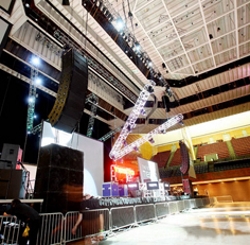
Thus it appears that different types of tests on the same items can yield corresponding results. In fact, experience has shown that such relationships hold in some cases but not in others, and that it may be difficult to predict which is which.
And in many cases, no acceptable substitute for a listening test has yet been found. Worse, some widely accepted tests might prove inadequate.
Loudness
It’s obvious that any sound system must provide enough sound level at the audience locations to ensure a satisfactory listening experience. Defining what this level actually should be is less obvious, and use of a valid measurement technique is not obvious at all.
Subjective opinions on appropriate sound levels often vary widely as well, depending on a host of factors. (Investigating this matter alone could become a major research project!)
In fact, the correct sound level may not be just a matter of loudness. How well speech is understood (intelligibility) is often the overriding concern, and this is the result of many factors other than just loudness. In some cases, the loudness may need to be set other than as would normally be expected, because of adverse acoustical or system functional characteristics.It may also be found that the audience prefers a sound level different from that which exists near the performer.
Other acoustical factors may be highly significant as well The level of the reinforced sound must be sufficiently higher than that of any background noise so that speech intelligibility or program enjoyment is maintained.

Some guidelines in this regard have been established empirically, and they may be adequate for most situations. A common and complicating factor is that background noise level may vary significantly, rapidly and unpredictably. Further, since adequate performance in this area may be a matter of life safety, accuracy can be quite important.
It’s often the case that the desired sound level is greater than that which the system is capable of producing without difficulty. This difficulty is the result of one or more components overloading, which results in an audible distortion of the sound.
Distortion may take various forms, depending on the type of component that is overloaded, the magnitude of the overload, and the nature of the program material, among other factors. Therefore, the audibility of the distortion may vary greatly with the situation, and each type of distortion must be evaluated individually.
Many listeners even believe that certain types of distortion are desirable, such as that typically produced by vacuum tube amplifiers. This usually applies to music playback systems in small rooms, however, so it’s unclear if such an effect is valid in a larger sound reinforcement situation.
Some devices are available that deliberately introduce controlled distortion, specifically for pro audio applications. Many have noticed that a limited amount of distortion adds to the apparent loudness of amplified sound, and without being objectionable. If anyone has actually studied this effect, the results remain obscure
